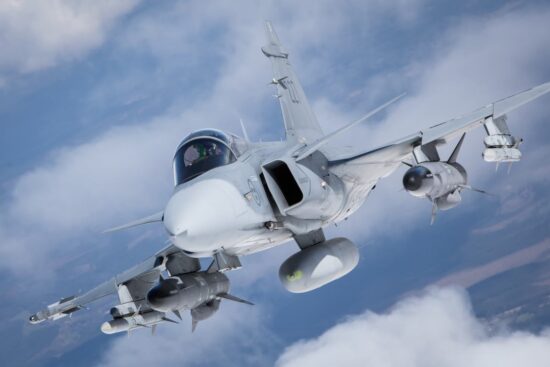On October 22, Swedish defense officials announced intentions to supply Ukraine with more than 100 Gripen fighters, a move that could be financed by frozen Russian assets.
Announcement and Intentions
The initiative was unveiled on October 22 at Saab’s Linköping plant, where President Vladimir Zelenskiy and Swedish Prime Minister Ulf Kristersson attended. They said that, if realized, the deal would significantly rebuild Ukraine’s military aviation, but the remarks were only expressions of intent, not a signed contract.
Scale of the Potential Deal
Both politicians stated that Ukraine intends to acquire at least 100 Gripen aircraft, possibly up to 150. For Sweden, this would be its largest export contract for the fighter, surpassing the 45‑aircraft deal with Brazil. In total, only about 100 of the 260 Gripens ordered by Sweden over three decades are currently in service. The procurement would also entail training, spare parts, and modernisation, with acquisition costs comprising roughly a third of the total lifetime expenditure. A representative of the Thai Defence Ministry quoted a price of around $85 million per aircraft in 2022, implying a contract between $8.5 billion and $12.7 billion.
Financing Challenges and Frozen Russian Funds
Kristersson acknowledged a long way to go. Ukraine largely relies on Western financial support and does not have the required funds internally. Swedish Defence Minister Pal Jonson suggested that Russia could contribute by using about €7.35 billion (≈$8.5 billion) of frozen Russian assets held in 2022 in European institutions. Negotiations are underway to transform those funds into a €140 billion loan on preferential terms for Ukraine, potentially sustaining procurement for 2–3 years.
Production Capacity Constraints
Even if financing were secured, contracting details and Saab’s production limits present hurdles. Ukraine has signed numerous preliminary cooperation agreements, such as an order for 1000 CV90 infantry fighting vehicles (only 40 delivered by Denmark and Sweden) and German Panther tanks and Lynx air‑defence vehicles, yet it is unclear whether a German factory will become operational in Ukraine. Saab has upgraded its line and could output 20–30 Gripens a year, but fulfilling a large‑scale Ukrainian order would likely span a decade.
Strategic Fit and Reliability
For Ukraine, the Gripen offers a pragmatic option: it matches the U.S. F‑16 in capability, belongs to the fourth‑generation family, and its latest E variant adheres to modern standards. While the aircraft’s price may trail the F‑16, U.S. support can be uncertain due to domestic politics. Sweden presents a more stable partnership, though the Gripen contains foreign components—including General Electric engines—making some American involvement unavoidable.
Operational and Cost Advantages
Designed for dispersed operations, the Gripen can operate from small, provisional airfields or even road segements, providing resilience against long‑range attacks. It boasts low maintenance costs and a lightweight profile ideal for provisional runways, matching Sweden’s historical approach during the Cold War. Although it does not reach the firepower of the F‑35, it remains a solid choice for Ukraine’s evolving air force, potentially complementing seized or purchased F‑16s.










